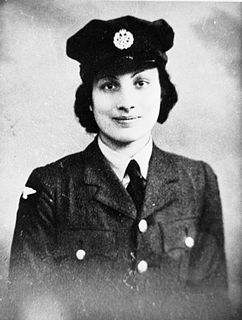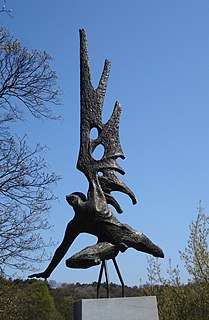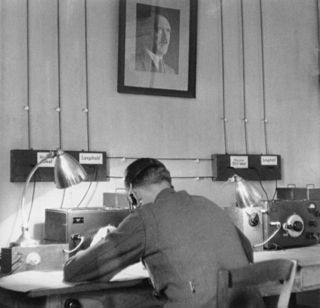The Special Operations Executive (SOE) was a secret British World War II organisation. It was officially formed on 22 July 1940 under Minister of Economic Warfare Hugh Dalton, from the amalgamation of three existing secret organisations. Its purpose was to conduct espionage, sabotage and reconnaissance in occupied Europe against the Axis powers, and to aid local resistance movements.

Signals intelligence (SIGINT) is intelligence-gathering by interception of signals, whether communications between people or from electronic signals not directly used in communication. Signals intelligence is a subset of intelligence collection management. As classified and sensitive information is usually encrypted, signals intelligence in turn involves the use of cryptanalysis to decipher the messages. Traffic analysis—the study of who is signaling whom and in what quantity—is also used to integrate information again.

Operation Fortitude was the code name for a World War II military deception employed by the Allied nations as part of an overall deception strategy during the build-up to the 1944 Normandy landings. Fortitude was divided into two sub-plans, North and South, with the aim of misleading the German High Command as to the location of the invasion.
84 Avenue Foch was the Parisian headquarters of the Sicherheitsdienst (SD), the counter-intelligence branch of the SS during the German occupation of Paris in World War II.

Noor-un-Nisa Inayat Khan, GC, also known as Nora Inayat-Khan and Nora Baker, was a British resistance agent in France in World War II who served in the Special Operations Executive (SOE). The purpose of SOE was to conduct espionage, sabotage, and reconnaissance in countries occupied by the Axis powers, especially those occupied by Nazi Germany. SOE agents allied themselves with resistance groups and supplied them with weapons and equipment parachuted in from the United Kingdom.

The Red Orchestra, as it was known in Germany, was the name given by the Abwehr Section III.F to anti-Nazi resistance workers in August 1941. It primarily referred to a loose network of resistance groups, connected through personal contacts, uniting hundreds of opponents of the Nazi regime. These included groups of friends who held discussions that were centred on Harro Schulze-Boysen, Adam Kuckhoff and Arvid Harnack in Berlin, alongside many others. They printed and distributed prohibited leaflets, posters, and stickers, hoping to incite civil disobedience. They aided Jews and resistance to escape the regime, documented the atrocities of the Nazis, and transmitted military intelligence to the Allies. Contrary to legend, the Red Orchestra was neither directed by Soviet communists nor under a single leadership. It was a network of groups and individuals, often operating independently. To date, about 400 members are known by name.
Horst Kopkow was a Nazi German SS major who worked for German Security police and, after the war, was concealed by British intelligence to use his knowledge during the Cold War.

Englandspiel, or Operation North Pole, was a successful counterintelligence operation of the Abwehr from 1942 to 1944 during World War II. German forces captured Allied resistance agents operating in the Netherlands and used the agents' codes to dupe the United Kingdom's clandestine organization, the Special Operations Executive (SOE), into continuing to infiltrate agents, weapons, and supplies into the Netherlands. The Germans captured nearly all the agents and weapons sent by the United Kingdom (Britain).
Major Joseph Antoine France Antelme OBE, no. 239255, was one of 14 Franco-Mauritians who served in the Special Operations Executive (SOE), a World War II British secret service that sent espionage agents, saboteurs and guerrilla fighters into enemy-occupied territory.
Hans Josef Kieffer was a Sturmbannführer (Major) and the head in Paris of the Sicherheitsdienst (SD), the intelligence agency of the SS during the German occupation of France during the Second World War. Kieffer's headquarters were at 84 Avenue Foch, an address that became well-known because many captured agents of the United Kingdom's clandestine Special Operations Executive (SOE) were interrogated there after their capture. After their interrogation, captured agents were sent to concentration camps in Germany and most were executed. Kieffer was successful in penetrating and destroying SOE networks, which had as their objective fostering and supporting the French Resistance to the German occupation. Kieffer deceived SOE headquarters in London for many months in 1943 and 1944 by sending false wireless messages, a tactic known as Funkspiel.

The Abwehr was the German military-intelligence service for the Reichswehr and the Wehrmacht from 1920 to 1944. Although the 1919 Treaty of Versailles prohibited the Weimar Republic from establishing an intelligence organization of their own, they formed an espionage group in 1920 within the Ministry of Defence, calling it the Abwehr. The initial purpose of the Abwehr was defence against foreign espionage: an organizational role which later evolved considerably. Under General Kurt von Schleicher the individual military services' intelligence units were combined and, in 1929, centralized under Schleicher's Ministeramt within the Ministry of Defence, forming the foundation for the more commonly understood manifestation of the Abwehr.
Morale Operations was a branch of the Office of Strategic Services during World War II. It utilized psychological warfare, particularly propaganda, to produce specific psychological reactions in both the general population and military forces of the Axis powers in support of larger Allied political and military objectives.
Rita Arnould was a housekeeper and courier of the Red Orchestra resistance group in Belgium during World War II. She was captured when the Funkabwehr raided an apartment at 101 Rue des Atrébates in Brussels on 12 December 1941 2 pm. from which a Soviet clandestine radio station was being run.

Wilhelm Vauck was a German mathematician, physicist and university lecturer in physics and electrical engineering. During World War II, Vauck was the director of the agents Referat within the Funkabwehr, the German Armies radio counter-intelligence organisation. As an anti-nazi, Vauck's work on the discovery of the Rote Kapelle anti-fascist resistance group during World War II, burdened him deeply until the end of his life.
Funkabwehr, or Radio Defense Corps was a radio counterintelligence organization created in 1940 by Hans Kopp of the German Nazi Party High Command during World War II. It acted as the principal organization for radio Counterintelligence, i.e. for the monitoring of illicit broadcasts. The formal name of the organization was the Funkabwehr des Oberkommandos der Wehrmacht (OKW/WNV/FU). Its most notable breakthrough occurred on 26 June 1941, when tracing teams at the Funkabwehr station at Zelenogradsk made the discovery of the Rote Kapelle, the anti-Nazi resistance movement in Berlin and two Soviet espionage rings operating in German-occupied Europe and Switzerland during World War II. The Funkabwehr was dissolved on 30 April 1945.

Anatoly Markovich Gurevich was a Jewish Soviet intelligence officer. He was an officer in the GRU operating as "разведчик-нелегал" in Soviet intelligence parlance. Gurevich was a central figure in the anti-Nazi Red Orchestra in France and Belgium during World War II.
Sonderkommando Rote Kapelle was a German special commission that was created by German High Command in November 1942, in response to the capture of two leading members of a Soviet espionage group that operated in Europe, that was called the Red Orchestra by the Abwehr. The Sonderkommando Rote Kapelle was an internal counter-intelligence operation run by the Abwehr and the Gestapo. Consisting of a small independent Gestapo unit and led by SS-Obersturmbannführer Friedrich Panzinger and investigated by Karl Giering, its remit was to discover and arrest members of the Red Orchestra in Germany, Belgium, France, Netherlands, Switzerland and Italy during World War II.
Karl Giering was SS-Hauptsturmführer and Criminal Councillor in the Geheimes Staatspolizeiamt Berlin (Gestapo) and later Head of Department IV A 2 in the Reichssicherheitshauptamt (RSHA). Giering is regarded as one of the most dangerous persecutors of the communist resistance against the Nazi regime. He commanded the Gestapo to smash the apparatus of the Betriebsberichterstattung (BB) of the Communist Party of Germany (KPD) and conducted investigations against the Soviet espionage network known as the Red Orchestra while part of the Sonderkommando Rote Kapelle.
The Prosper Network, also called the Physician Network, was the most important network in France of the Special Operations Executive (SOE) in 1943. SOE was a secret British organization in World War II. The objectives of SOE were to conduct espionage, sabotage, and reconnaissance in occupied Europe and Asia against the Axis powers, especially Nazi Germany. SOE agents in France allied themselves with French Resistance groups and supplied them with weapons and equipment parachuted in from Britain.
Erna Frida Eifler was a German steno typist secretary who became a communist, resistance fighter, Soviet GRU agent and courier.







